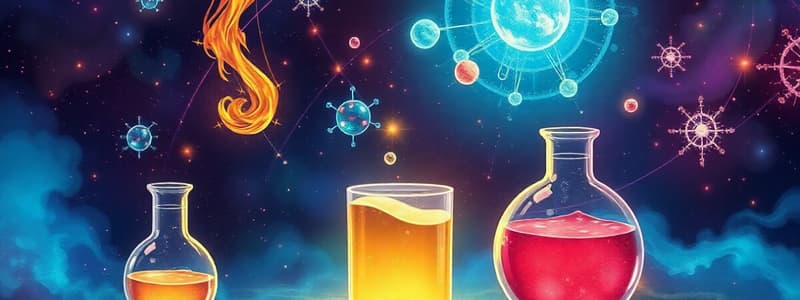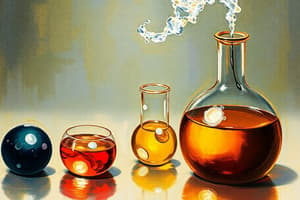Podcast
Questions and Answers
Which one of the following orbitals is filled with electron in the ground state hydrogen atom?
Which one of the following orbitals is filled with electron in the ground state hydrogen atom?
- None of these
- p orbital
- s orbital (correct)
Which process is an oxidation?
Which process is an oxidation?
- Mg = Mg+ + 2e- (correct)
- H₂ = 2H
- Na = Na+ + e- (correct)
- NaCl + AgNO₃ = AgCl + NaNO₃
- Zn+ 2e- = Zn
What is the maximum number of electrons on an L shell?
What is the maximum number of electrons on an L shell?
- 8 (correct)
- 12
- 6
- 10
- 14
Which one is a primary bond type?
Which one is a primary bond type?
Brønsted bases are...
Brønsted bases are...
Solution A has a pH = 1, and solution B has a pH = 2. This means the concentration of H+ ions is...
Solution A has a pH = 1, and solution B has a pH = 2. This means the concentration of H+ ions is...
Define "boiling point"
Define "boiling point"
Define the density of a solution. What is the unit of density? Is it an extensive or an intensive property?
Define the density of a solution. What is the unit of density? Is it an extensive or an intensive property?
Define the Gibbs free energy with formula!
Define the Gibbs free energy with formula!
What is micelle? Write an example for a material that builds up micelle.
What is micelle? Write an example for a material that builds up micelle.
What does "ligand" mean in complexometry? What are the common properties of ligands? Write two examples for ligands.
What does "ligand" mean in complexometry? What are the common properties of ligands? Write two examples for ligands.
Write the ideal gas law, and name the symbols
Write the ideal gas law, and name the symbols
What does the "delocalized" bond mean? Show an ion or a molecule contains delocalized bond!
What does the "delocalized" bond mean? Show an ion or a molecule contains delocalized bond!
Flashcards
Covalent bond
Covalent bond
A chemical bond involving the sharing of electron pairs between atoms.
Oxidation
Oxidation
The loss of an electron.
Boiling point
Boiling point
The temperature at which a liquid boils and turns into gas. The boiling point temperature may vary, depending on the element. Vapour pressure of liquid = external pressure.
Freezing point
Freezing point
Signup and view all the flashcards
Half-life
Half-life
Signup and view all the flashcards
Ionization energy
Ionization energy
Signup and view all the flashcards
Electron affinity
Electron affinity
Signup and view all the flashcards
Exothermic reaction
Exothermic reaction
Signup and view all the flashcards
Endothermic reaction
Endothermic reaction
Signup and view all the flashcards
Solubility
Solubility
Signup and view all the flashcards
Buffer solution
Buffer solution
Signup and view all the flashcards
Dialysis
Dialysis
Signup and view all the flashcards
Colloid
Colloid
Signup and view all the flashcards
Avogadro's number
Avogadro's number
Signup and view all the flashcards
Emulsion
Emulsion
Signup and view all the flashcards
Suspension
Suspension
Signup and view all the flashcards
Ionization energy
Ionization energy
Signup and view all the flashcards
Catalytic poison
Catalytic poison
Signup and view all the flashcards
Critical pressure
Critical pressure
Signup and view all the flashcards
Double bond
Double bond
Signup and view all the flashcards
Bond order
Bond order
Signup and view all the flashcards
Osmotic pressure
Osmotic pressure
Signup and view all the flashcards
Isolated system
Isolated system
Signup and view all the flashcards
Le Chatelier's Principle
Le Chatelier's Principle
Signup and view all the flashcards
Hybridization
Hybridization
Signup and view all the flashcards
Evaporation
Evaporation
Signup and view all the flashcards
Condensation
Condensation
Signup and view all the flashcards
Electromotive force (EMF)
Electromotive force (EMF)
Signup and view all the flashcards
Coagulation
Coagulation
Signup and view all the flashcards
Anions
Anions
Signup and view all the flashcards
Cations
Cations
Signup and view all the flashcards
Azeotrope
Azeotrope
Signup and view all the flashcards
Hess's Law
Hess's Law
Signup and view all the flashcards
Study Notes
Chemistry Exam Review - 2018/19
- Orbital Filling: The ground state hydrogen atom's electron fills the 1s orbital.
- Oxidation: A process where an element loses electrons. Examples: Mg → Mg²⁺ + 2e⁻ or any other reaction that demonstrated oxidation.
- Electron Shell Capacity: The maximum number of electrons in the L shell is 8.
- Primary Bonds: Ionic bonds, covalent bonds, and metallic bonds are primary bond types. Examples: Ionic bond (NaCl), covalent bonds, metallic bonds.
- Brønsted Acids/Bases: Brønsted acids are proton donors (e.g., HCl), and Brønsted bases are proton acceptors (e.g., NH₃).
- Lewis Acids/Bases: Lewis acids are electron-pair acceptors, and Lewis bases are electron-pair donors.
- pH and Concentration: A solution with pH 1 has 10 times higher H⁺ concentration than a solution with pH 2.
- Boiling Point: The temperature at which a liquid turns into a gas, when the vapor pressure equals the external pressure.
- Density: Density is the mass of a substance per unit volume (g/dm³). It's an intensive property.
- Gibbs Free Energy: A thermodynamic quantity (ΔG = ΔH - TΔS), where ΔG = Gibbs Free Energy, ΔH = enthalpy, T = temperature in Kelvin, ΔS = entropy. Gibbs Free Energy is the energy in a system or process available to do useful work.
- Micelles: Aggregates of surfactant molecules in a liquid colloid, with hydrophobic tails grouped in the center and hydrophilic heads facing outwards. Ex. Soap.
- Ligands: Molecules or ions attached to a metal atom through coordinate bonding. Ex. NH₃, Cl−, H₂O
- Ideal Gas Law: PV = nRT; P = pressure, V = volume, n = moles, R = gas constant, T = temperature
- Delocalized Bonds: Electron density spread throughout the molecule, rather than in one fixed position, e.g benzene.
- Exothermic/Endothermic Reactions: Exothermic reactions release energy, while endothermic reactions absorb energy.
- Isotopes: Atoms with the same atomic number but different mass numbers (e.g. isotopes of Carbon).
- Colligative Properties: Properties of solutions that depend on the concentration of solute particles, but not their identity. Examples: vapor pressure lowering, boiling-point elevation, freezing-point depression, osmotic pressure.
- Ionization Energy: The amount of energy required to completely remove an electron from a gaseous atom. Higher ionization energy is associated with elements that are further right and higher up in the periodic table.
- Galvanic/Electrolysis Cells: Galvanic cells use spontaneous redox reactions to produce electrical energy, while electrolysis uses electrical energy to drive non-spontaneous redox reactions.
- Bond Order: Half the difference between the number of bonding and antibonding electrons in a molecule.
- Indicators: Substances that change color depending on the pH of a solution, e.g. litmus, phenolphthalein
- Colloidal Systems: Mixtures that have particles of one substance dispersed in another, with the dispersed particles remaining suspended. Properties of these systems include the Tyndall effect and how they are classified according to their internal and external phases.
- Solubility: The ability of a substance (solute) to dissolve in a solvent.
- Buffer System: A solution that resists changes in pH when small amounts of acid or base are added (e.g. Weak acid and its conjugate base, or a weak base and its conjugate acid).
- Catalyst: Substances that increase the rate of a chemical reaction without being consumed in the process.
- Autocatalysis: A reaction where one of the products acts as a catalyst for the reaction.
- Standard Cell Potential: Calculated to find the emf, or electromotive force which can be used to determine the energy related to chemical reactions. Eocell = Eocathode - Eoanode
- Hund's Rule: Electrons fill degenerate orbitals singly first before pairing up.
- Alkaline Substances: Sodium hydroxide (NaOH), potassium hydroxide (KOH), and calcium hydroxide (Ca(OH)₂).
- Detecting Substances: Examples: detection of arsenic ions (Griess-Ilosvay reagent), detection of sulfide ions, and detection of iron(III) ions.
- Hydrogen Bonding: A special type of dipole-dipole attraction that occurs between a hydrogen atom bonded to a highly electronegative atom (like O or N) and another electronegative atom.
- Hess' Law: The enthalpy change for a reaction is the same regardless of the reaction pathway
- Strong and Weak Acids/Bases: Strong acids/bases ionize completely in water, while weak acids/bases ionize partially.
- Henry's Law: The solubility of a gas in a liquid is directly proportional to the partial pressure of the gas above the liquid.
- Multidentate Ligands: Ligands with more than one donor atom that can coordinate with a central metal ion e.g., to form chelate complexes
Studying That Suits You
Use AI to generate personalized quizzes and flashcards to suit your learning preferences.




